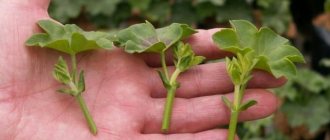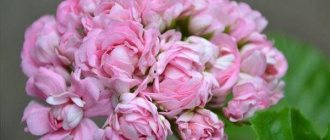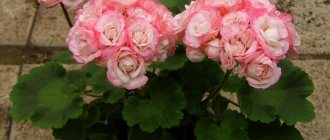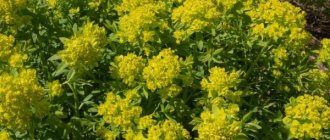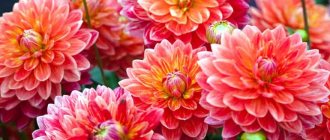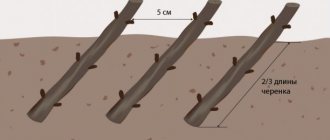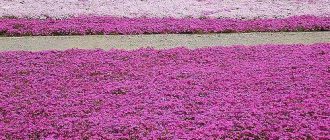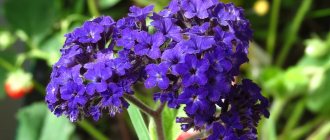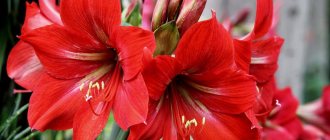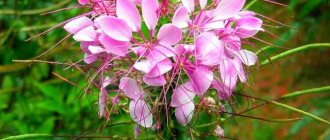What kind of flower is this?
Pelargonium is a herbaceous semi-shrub flower. There are already more than 400 varietal varieties around the world. The name comes from the shape of the fruit, which was similar to a crane's beak. The first species were identified in Africa. The pleasant smell and neatness have been loved since ancient times, and after that they began to appear in every home. Popularity arose due to active growth and unpretentious care. In warm climates, the plant lives in the garden, as the height can reach large sizes.
Reproduction
You can get new plants:
- sowing seeds;
- rooting the cuttings.
When propagated by seeds, especially those obtained at home, it is possible to obtain completely different plants that differ from the mother plant. Therefore, it is better to use seed grains purchased in specialized stores. Sowing of seedlings is carried out in the second - third month of winter:
- seeds are distributed over the surface of moist soil, sprinkled with a thin layer of earth;
- cover with film and place in a warm, bright place;
- shoots will appear in a week;
- when the seedling has two true leaves, they are picked one at a time - two seedlings per pot;
- When 5–6 leaves appear, the first pinching is performed.
For propagation, you can take twigs obtained by trimming a flower, or specially cut cuttings 2.5 cm long. Dry the cut area and sprinkle it with root growth stimulants. Plant the prepared cuttings in moist soil and leave uncovered. With regular watering and an air temperature of about 21°C, rooting occurs within 2–3 weeks. When the sprout produces five leaves, you need to pinch the crown.
If you follow these simple rules of care, pelargonium will reward you with lush, long-lasting flowering.
Names of species with descriptions and photos
There are a huge number of varieties of pelargoniums and the classification of some species is still unclear. Let's move on to the most famous plants that can be found in every person's home.
Orange
Orange pelargonium grows up to 35 cm in height. An unusual appearance with a peach cap on each bud and a greenish tint on the edge. With good care, 240 inflorescences change over 4 seasons. Provides a pleasant view from the balcony. Does not require special attention. Prefers semi-shaded areas. It should be watered abundantly, a little less in winter. In summer it is best to take it out into the fresh air. You can plant seeds in any weather.
Ice Rose
White ivy-leaved pelargonium. The foliage is medium sized, dark green. Compact plant. It does not grow quickly, but the buds of this variety are worth it. The flowers grow large, up to 6 cm, and are shaped like a rose. If you keep the plant in the sun a little, you can achieve a slight lilac tint.
Unique
It is different from all the others, because even the origin of this plant is still unclear. The species is not assigned to any classification, which is why it is called unique. Its foliage refers to dissected leaves. The aroma is piquant, without too much harshness. The small flowers look like a bird's feather. Plants can have either single or bicolor foliage. The variety is classified as tall. The peak of popularity of uniques took place at the end of the 19th century.
Iris confetti
Refers to zonal pelargonium. Their flowers are whitish with a pinkish tint in the middle. Foliage is small in size. In a pot it looks impressive and without unnecessary flaws. In the sun it takes on a brighter tone. And in winter it requires special care and feeding.
Mini Diana
Miniature golden leaf pelargonium. Belongs to the zonal group. Despite their small size, the flowers are large, white-pink in color and have a pleasant golden tint. The leaves are semi-double with a light green tint. Each leaf has a bright brown zone. Blooms at an accelerated pace. Not whimsical. In a small pot the flower looks compact and fluffy.
Diana Palmer
Zonal pelargonium. The petals are wavy with jagged edges in the shape of a carnation. Light shading. A spectacular bush, not fussy in flowering. Has a pastel orange tone. In order for a flower to sprout, it needs pruning. It bushes well, looks large and has grown. The leaves are compact. Inflorescences grow up to 5 cm. Quite a well-known variety. Mostly good flowering occurs in the summer. This plant needs feeding.
Natalie
Small semi-double species pelargonium. The first flowers are 4 cm in size. It grows in large caps. The bush is elegant, compact, but rather capricious. Not very tall. After pruning, it does not sprout immediately; most often it only replaces it. Responsive to temperature changes. The variety is tender. It has a peach color with a pale white edging of the petals. The trunk is almost always not leafy. Formation does not happen immediately. In hot weather it can throw leaves. The plant is worthy of attention for its dissimilarity.
Powder pouf
Small zonal pelargonium with salmon color. The lining of the petals is light, and the leaves themselves have a dark zone. Neat fluffy bush. The heat makes the cap white and thick, which creates a nice contrast. Shoots form quickly. Bright and pleasant to look at. There are almost always many buds present. The plant itself is small in size, which is why it will look perfect on the windowsill. Spraying is useful. Take it out onto the balcony only in hot weather. Dwarf variety.
Bornholm
A dense double flower in the form of an unopened rosebud. The petals of this plant are deep red. Each rose is 1 cm. In hot weather, the red color becomes a little paler, and in winter, on the contrary, it acquires a bright shade. The inflorescence is dense. Peduncles of medium height. Green sheets with a cream-colored mosaic pattern. Belong to the zonal type. It blooms in the shape of a cap. Over time it grows to medium size.
Albina
Pelargonium Albina grows quite quickly. After the cuttings have appeared, the peduncle rises on the 3rd day. However, the first flowering is not particularly abundant. 4 flowers grow on 1 peduncle. Large plant. It belongs to the zonal species and is considered a dwarf in height. The leaves are intense green. The flowers themselves are double, white with a small red stamen, and collected tightly. Due to the density of this species, the plant looks collected and neat. He loves feeding, so thanks to courtship, the flowers become larger. Suitable for beginners who take responsibility.
Elmset
Zonal variety of dwarf speckled pelargonium. Flower growers are attracted by the bright, golden-green leaves with creamy double flowers and red veins. The flower is decorated with light, bright crimson specks. Durable. With a neat shape, blooms profusely. The bush is well-fed and strong. Does not throw leaves, bushes on its own.
Dovepoint
A neat decorative border and a barely noticeable pink color, which echoes white, distinguish this plant variety from other terry types. The inflorescences are dense and delicate, voluminous compared to the dwarf type. In the sun, the bloom of dovepoint turns from white to pink. Peduncles are short.
Crown Princess Mary
Mary belongs to the double zonal pelargoniums. The inflorescences are tight, reminiscent of a rose. They grow up to 10 cm. The flowers themselves are white with a small green one in the center. When blooming, it may acquire a slight pinkish tint. The bush is fluffy. Blooms profusely in spring and summer. Should be replanted annually. Loves the sun and warmth. Tries to bloom even in low light. Prefers complex feeding. The name of this variety goes well with the name.
Princess Sandra
Terry pelargonium belongs to the zonal type. The flower is light red with a white section in the center. According to the type of growth, it is considered a standard pelargonium, which means it can grow quite large.
Passat
The double trade wind flower amazes with its light pinkish tint of ruffled petals. The density of this variety resembles a delicate fluffy pompom. The species is known among pelargonium lovers and beginners. The bushes require help in shaping , but with good care they bloom efficiently and abundantly. A sunny variety that will warm you even in cloudy weather. You can also see what this varietal flower looks like in the photo.
Peppermint twist
Terry pelargonium. Large flowers with a peachy-pinkish color, densely strewn with cherry speckles. The leaves are green with a brown zone in the center of the leaf. They retain their decorative appearance for a long time. Standard bush, blooms profusely. A bright variety for lovers of variegated plants.
Lake
The wavy petals of Pelargonium Laque are colored orange, and towards the edge of the flower they become completely white. The clearly colored color can only be seen in the sun. In the shadows the color fades. The plant belongs to the usual zonal variety, but in addition it requires careful formation. The leaves are elegant, thanks to the contrasting border of a brownish-green hue.
Bronze butterfly
In the center of the leaf there is a light shade in the shape of a butterfly , which, when basking in the sun, can give a bronze tint. The flower itself is large, peach-colored, and needle-shaped. The variety is not tall, the peduncles are short. Requires shaping. Bushes and blooms for quite a long time. Not afraid of rain and heat. Looks great on the balcony in summer. The size can be easily adjusted using a small flowerpot. Unpretentious, fast growing. It is the unusual leaves that make this species special.
Magnus
Terry zonal pelargonium plant. Flowers in the form of a red rose. The flower itself is bright and velvety. Blooms profusely and looks compact. The hat is round. The leaves are green, iridescent with a slight brown tint. In person it has a very bright colorful color.
Tsarskaya
In summer, you can see this type of plant in vegetable gardens, flower beds and balconies. It is distinguished by lush flowering and grace. Quite demanding to care for. It blooms for a short time, about 5 months. But if you see this plant even once, you will immediately want to bring it to your windowsill. Royal pelargonium grows up to 60 cm in height.
It differs from its colleagues by folded multi-colored leaves, dense leaf plate and jagged edges.
It can tolerate a little shade, but will bloom a little less luxuriantly. Prefers nutritious soil. You can add a little clay mixture to the soil. In cold weather, the temperature should not be lower than 12ºС.
Tamara
Tamara is many-sided and unique. The flowers are like dense pink and white marshmallows. The color is variable with pink veins and a border of the same color. The plant is tender and airy. Compact bush with small leaves. It blooms from infancy and never ceases to delight with the process. The petals are neat, with pointed tips.
Red
Sunny side required. The soil should be kept moist constantly, but in moderation. It is recommended to spray. Red pelargonium grows up to 30 cm in length. It should be placed on the balcony immediately after frost has passed.
It has a bright shade and universal resistance to all weather conditions. The variety branches well. There are huge inflorescences. The color of this type of pelargonium is similar to wine red. The leaves are classified as ivy-leaved. Grows quickly. Landing 30×30.
Maverick white-pink
The plant is 30 cm tall with good branching. White-pink color. The inflorescences are large. The leaves are green with a slight dark tint. Drought resistant. Preference is given to sunny places with fertile soil. You can start planting from the end of January. The depth for seeds is 0.5 cm. If you maintain a temperature of 20°C, then seedlings can be seen within a week.
Tuscany
Pelargonium is a non-double, ivy-leaved plant. Large caps and beautifully colored in a variety of shades. Blooms profusely, completely covered with inflorescences. There are two types of Tuscany that are currently popular.
Bernd
Bright flowers, opening wide, deep red. Each leaf is dark green with a bright brown ring. Classified as semi-double. The bush is harmonious, never stretched out. The lower part of the flower must be compacted tightly.
Hero
Large flowers of a crimson-red hue with white dots on the leaves. The bush is fluffy. It grows slowly, but branches very well. The leaves are medium-sized, dark green. The bush is low, the average height is up to 25 cm. The color is very rich. Does not require growth regulators.
apple blossom
Herbaceous plant with a fragrant aroma. The height of the bush is 25 cm. The leaves are round, green with a small red edge. The flowers are pink with a slight pallor in the form of a spherical inflorescence. The plant prefers light. For feeding, a turf mixture is chosen, and moderate moisture is preferred. If the flower is treated with love, the flowering will continue all summer. In the fall, a transplant and a bright place in the room are necessary. For seeds to germinate, the temperature must reach 20°C.
Black velvet
The difference between black velvet is in the unusual chocolate sheets, which create a wonderful combination with bright red inflorescences. If the bush is formed recently, then you will notice that at the initial stage there is a bronze coating on the sheets. The height of black velvet reaches about 40 cm. The shoots are strong. Loves light, but the sun's rays should not touch the petals.
Pelargonium is unpretentious, but this does not mean that it does not need care. Periodically you need to check the soil and water on time. Prefers mineral fertilizers. Sowing 1 cm. It is not recommended to allow the soil to dry out.
Indoor hybrids
The hybrid variety grows well at home. It looks like a large shrub up to 75 cm in height. Rounded green leaves. The flowers are umbellate up to 3 cm, come in multi-colored shades, namely: white, pink, red, purple. Flowering lasts six months.
The most popular pelargonium hybrids include two species.
Ardens
Rare hybrid plant. Wine red flower with a black stripe down the middle. This hybrid plant is easy to care for, but requires light. Moderate watering is required. An adult plant reaches a height of 20 cm.
Miss Stapleton
The plant never sleeps. This heart-shaped hybrid looks like a bouquet of pink roses. The stems are hard with stipules in the form of thorns.
Scarlet
Rosaceous pelargonium. The flowers are dense, double. The petals have two colors. The inside is like red wine and the outside is silver. The inflorescences are dense. The leaves are greenish, folded.
Madam
Madame Pelargonium has several varieties. Let's look at the main ones.
Bovary
Type of double zonal pelargonium. Fluffy bush. Blooms profusely. The flowers look like dark red wine , there are bright and large inflorescences. It is necessary to keep the soil moist and spray as often as possible.
Celeron
Graceful pelargonium with variegated leaves. The leaves are long-stemmed, gray-green with a wide cream edge. Has thin cuttings. Belong to the dwarf group. Blooms in bright pinkish color. The variety hardly blooms, but captivates with its beauty. The bush is compact and pleasant to look at.
Fisher appleblossom
Large flowers resembling a rose. The plant is white, with a rich white-pink border. Tight caps. The bush needs shaping. The leaves are green and have a dark zone. Requires special care.
Blue
Terry ivy-leaved pelargonium. The flowers have a similar blue-lilac hue. Compact bush. Needs a sunny area. Requires daily care. The plant needs additional minerals.
Miniature varieties
Miniature pelargoniums first appeared in England. The height of small pelargonium starts from 8 cm and ends at 15 cm. Ideal for the home, they can also be placed on balcony boxes. The leaves come in a variety of green shades. Pelargoniums are light and airy, but this is not their only advantage. They are compact. They can bloom in any decade.
Small plant species are currently divided into groups:
- Zonal.
- Ivy-leaved.
- Royal.
- Variegated.
- Succulents.
- Fragrant.
Most of the plants belong to the zonal species. The name was derived from the small zones on each leaf. Usually these are dark brown zones that are located in the center. It was thanks to breeders from England that small varieties of pelargonium appeared.
Among the most worthy breeders is Stanley Stringer. He was born in a small village called Okkold. He took up selection at the age of 50. The most popular variety grown is Alde, which can still be seen on shelves today. Varied
Deacons are also a dwarf variety of Stringer. Among them, the best are: tangerine and moonlight. The tangerine's flowers are orange-red in color, while the moonlight's are white-purple. The most impressive thing is that such a miniature plant has very large flowers.
One of its last cultivations is a golden goblet, which had a creamy hue and the petals were strewn with red dots. Stringer left behind about 160 varieties of pelargonium.
Ry Beatwell started his life as a postman. Therefore, it has a number of geographical names for varieties. Bitwell became famous for being able to develop a new type of pea variety. And they were covered with red, pink and purple specks.
Among the varieties with small spots, the most popular are: Milden, Semer and Elmsett. Milden has green-yellow leaves with bright white flowers flecked with pale pinkish. Semer is a dwarf species of pink flowers with red dots. Elmsett is a zonal species of pale pink flowers with red flecks. The latter species was named after Bidwell. The variety is decorated in wine color with green-red foliage.
And last but not least is the famous breeder Brian West. West is famous for developing a variety whose leaves resemble stars, which is why the variety is called star-shaped. The varieties have spread throughout the world. Even despite their unusual shape and the fact that they do not exactly resemble pelargoniums, they can be cared for in the same way as ordinary varieties.
In recent years, Vesta has seen the birth of miniature plants up to 8 cm. The varieties were named anni popham.
Catalog of pelargoniums: Zonal
Terry standard pelargonium. Quite a rare shade - bright, dark purple. The caps are very large, the flowering is abundant.
Standard zonal pelargonium. Huge caps of double salmon flowers. The leaf has a zone.
Zonal standard pelargonium. The leaf is dark, zoning is almost not expressed. Huge caps of double salmon flowers. Blooms generously. Luxurious! Exhibition variety.
Zonal terry pelargonium. The flowers are shaped like a park rose. Juicy fuchsia color. The underside of the petals is light.
Zonal variegated pelargonium. The flowers are large salmon pink. The bush is easy to form.
Standard pelargonium. Zoning on the leaves is not expressed. The inflorescence is dense, large, peach-pink in color.
Zonal standard pelargonium. Terry peach-pink flowers are collected in large caps, the petals are folded. Easy to form.
Zonal standard pelargonium. One of the most luxurious varieties of this variety series, huge caps of white-peach flowers, compact neat bush, blooms profusely. Exhibition variety.
Compact standard. The leaf is large, dark, dense. Flowers on short peduncles are bright red and very large. Huge hats look impressive. Flowery! The variety took part in the exhibition in July 2022.
New 2017. Zonal terry pelargonium. Very large flowers of creamy white color, with a transition to salmon color in the center.
Compact zonal pelargonium. Very large double burgundy-raspberry flowers with a white spot in the center. The leaves are large, dense, dark green.
Rules of care
Plants require special care and pelargonium is no exception. Usually the flower is located in the room, and begins to bloom profusely in the summer. In winter, it is necessary to ensure a temperature of at least 15 °C and avoid waterlogging of the soil. It is best to leave the plant on the sunny side, but only where there are no drafts.
Pruning is carried out after flowering - in autumn. But if the roots have grown well, an exception is made. It is recommended to transplant in February. For pruning, you need to leave shoots of about 10 cm. Do not forget about fertilizing for each flower.
Plants can lose their compactness if they are not given proper care.
After pruning, the cuttings should be left for 2 hours in a dry room with fresh air. After pruning, cover them with plastic bags to help them take root. For pelargonium to grow, a temperature of at least 20 °C is required.
In addition to beauty, pelargoniums also have medicinal qualities for people. After all, they contain an extract that cures respiratory tract infections. In addition, the oil of this plant has a calming effect. But the main thing is that the flower goes well with any landscape in the house and allows every housewife to feel like a woman.
dacha.expert
Flower passion.
I love all living plants. I see a highlight in each of them. But my strongest flower passion in recent years has been pelargoniums.
Dear readers, at the moment I have a small but amazingly beautiful collection of unusually blooming pelargoniums. I have “Rosebud” - pelargoniums blooming with roses, Tulip - blooming with tulips, asters, carnations, one variety - peonies. There are several fragrant varieties, with the scent of rose, lemon, wormwood, peach, and apple. And I want to share all this wealth with you.
Terms of sale of pelargoniums 2022
Sales all year round, subject to delivery by a transport company, by bus, I arrange it myself. To the order amount you need to add approximately 400 rubles for transportation and packaging. I don’t send pelargoniums by mail because they don’t arrive well, then they get sick for a long time and, as a rule, they don’t survive.
My email address
Viber and WhatsApp tel.
Apple Blossom Rosebud is a rosaceous zonal pelargonium. The plant is very large and fast growing. It requires the initial formation of the bush, and then it will show all the beauty and harmony of flowering. Loves very “fat” soil. Last year I fed them with liquid fertilizers for the flowering ones, but this year I just planted them in “humus” in the spring. The variety blooms very profusely, begins early in the spring and, probably, if not pruned in the fall, will bloom into the winter. This photo is fresh from autumn, I published it only because of its good quality, it does not reflect the true beauty of the variety. In summer the hats are much larger and denser. I especially admire roses - large white ones with a green center and pink edging of delicate petals.
.
anykadevyshki.ru
Natalia, I liked Stellar too :). I was about to send it to the flowerbed in the summer, but I realized that I didn’t want to be left without it and still grabbed the cuttings :). Now I'm glad he survived, he's a good breed. Sometimes you get tired of heavy double inflorescences and want simplicity, grace and clean lines. This is Monique Mc Ewan for my taste :).
forum.pelargonium-club.ru
Transplantation and propagation of pelargonium
The beautiful appearance of pelargonium and its regular flowering depends not only on watering and feeding, but also on regular pruning. At the same time, a new plant can be grown from the cuttings obtained.
It is recommended to carry out cuttings no more often than once every two years, so that the geranium has time to grow and develop. If the bush is small and weak, then once every three years. Cuttings can be taken at any time, including winter. If you do this in early spring, you can already see the first flowers in the summer.
Spring is also ideal for propagation because at this time all processes of growth and development are especially intense, which means that the cuttings take root faster and stronger. But this is only a recommendation, not a mandatory rule. Pelargonium tolerates cuttings well in any season. Perhaps you will be able to admire the first results next year.
To propagate pelargonium by cuttings, you need to take into account the following nuances:
- For dwarf varieties, the cutting length is up to 2.5 cm, for ordinary varieties - 5 cm;
— You can root the shoots in water or in the ground. To be on the safe side, use special means to improve rooting, which are used for processing cuts, but this is not necessary;
— For planting you will need pots with pallets, suitable soil mixture and sand;
— Choose a top with three or more leaves;
— It’s better not to cut branches with buds. If there are buds, it is advisable to remove them so that they do not draw resources onto themselves. A young plant will still not allow them to open;
— Cut the cuttings only with a sharp knife at a right angle. The cut cuttings need to be dried for several hours so that the cut is covered with a film. In the future, this will protect against rotting;
— Cuttings are planted in drained pots with holes. About a third of sand is added to the soil;
— To disinfect the soil, it is enough to treat it with boiling water or a weak solution of potassium permanganate;
— The cuttings go several centimeters into the soil. The earth needs to be slightly compacted so that the shoots do not fall;
— For the first days, keep the pots in the shade, but by the end of the week they can be moved to the sun and watered abundantly. Pour water not into the ground, but into a pan;
— Try not to wet the pelargonium leaves. This can cause them to become stained or even rot;
— The average duration of the rooting process of shoots is 2–6 weeks, depending on the variety of geranium;
— If you choose to root the cuttings in water, place them in pre-settled water. You can replant the stems when the roots grow more than 2.5 cm. Plant pelargonium as delicately as possible so as not to damage the rhizome.
Pelargonium April Snow
One of the followers of the Appleblossom Rosebud variety can be considered the dwarf pelargonium April Snow with double airy flowers in the shape of roses. The color of the flowers is white, but like the previous variety, the edges of the graceful petals are decorated with a soft pink stripe, and the central part of the corolla has a slight greenish tint.
The leaves of zonal pelargonium are bright, green, with an indistinct brownish zone. The creators of this variety tried to please those gardeners who could not afford to grow large Appleblossom Rosebud bushes, but April Snow will comfortably fit on the narrowest window sill in a city apartment.
Pelargonium PAC Viva Rosita
Rosaceous, very spectacular pelargonium PAC Viva Rosita is rightfully one of the most popular varieties of recent years. The uniqueness of the stocky plants, which readily produce lateral stems, is their ability to bloom long and profusely, forming inflorescences of 15–20 double flowers. The peduncles are strong and hold well such a number of multi-layered flowers, reminiscent of ancient park roses. The diameter of a single flower can reach 6 cm, while the inflorescences are loose, and you can easily see each miniature red-raspberry rose. Look also at the photo of Garden Tradescantia!
As soon as the bush begins to grow flower stalks, it urgently needs regular watering and fertilization, otherwise the loss of some buds cannot be avoided. Despite the apparent capriciousness shown in the photo, the pelargonium variety overwinters well and will be a welcome gift for any person who is partial to indoor floriculture.
Plant Collectors Data Bank
| Search for plants by name | Nurseries by region | Selling plants | Plant photo galleries |
| Peony photo galleries | Photo galleries of perennials | Photo galleries of flowers | Photo galleries of fruits |
| Photo galleries of shrubs | Photo galleries of irises | Phlox photo galleries | Houseplants |
| Photo galleries of garden flowers | Photo galleries of indoor flowers | ||
Photos of pelargoniums and names of varieties from the collection of A.N. Kostyrina, Bryansk region
Description of the composition of the entire Pelargonium collection by mail
Zonal pelargoniums with double (Double Zonale), semi-double (Semi-Double Zonale) and simple (Single Zonale) flowers get their name due to the concentric zone of a darker color, which is located in the middle of the leaf. They are the most common and are known as "indoor geraniums".
Pelargonium Sarah Hunt | Pelargonium Warrenorth Pearl | Pelargonium Bold Pixie | Pelargonium Bold Pixie | Pelargonium Sarah Hunt |
| Pelargonium Creamery | Pelargonium Ray Bidwell | Pelargonium Pac First Yellow | Pelargonium Pac Blue Wonder | Pelargonium PAC Harmony |
| Pelargonium Warrenorth Pearl | Pelargonium Pac Blue Wonder | Pelargonium Elmsett | Pelargonium Pac Shocking Violet | Pelargonium Bold Sunset |
| Pelargonium Peppermint Twist | Pelargonium Red Explosion | Pelargonium Pac Blue Wonder | Pelargonium High Tor | Pelargonium Tie Die |
| Pelargonium White Butterfly | Pelargonium Jessica | Pelargonium PAC Viva Maria | Pelargonium PAC Viva Maria | Pelargonium Tie Die |
| Pelargonium Magnus | Pelargonium Pac First Yellow | Pelargonium Frou Frou | Pelargonium Tresor | Pelargonium Shimmer |
| Pelargonium Warrenorth Pearl | Pelargonium Abba | Pelargonium Happy of New Life, foliage | Pelargonium Angelique | Pelargonium Regina |
| Pelargonium Frou Frou | Pelargonium Red Explosion | Pelargonium Emperor Nicholas | Pelargonium Odensjo Appolonia | Pelargonium Ainsdale Duke |
Pelargonium Joy | Pelargonium Helen | Pelargonium Red Explosion | Pelargonium Red Explosion | Pelargonium Mr Wren |
| Pelargonium Sussex Gem | Pelargonium Emperor Nicholas | Pelargonium Golden Anniversary | Pelargonium Great Bricett, foliage | Pelargonium Americana White Splash |
| Pelargonium Emperor Nicholas | Pelargonium Ivory Snow | Pelargonium Minx | Pelargonium Americana White Splash | Pelargonium Kronprinsesse Mary |
| Pelargonium Elmsett | Pelargonium Odensjo Poetry in Motion | Pelargonium Golden Anniversary | Pelargonium Skies of Italy | Pelargonium Peter Read |
| Pelargonium Bills Gem | Pelargonium Elspeth | Pelargonium Laureen Alexandra | Pelargonium Lara Harmony | Pelargonium Alex Kitson |
Pelargonium Orangesonne | Pelargonium Magnus | Pelargonium Deacon Finale | Pelargonium Sussex Gem | Pelargonium Cupid |
| Pelargonium Jessica | Pelargonium Flirt | Pelargonium Golden Anniversary | Pelargonium Dylan Cherone | Pelargonium Golden Choice |
| Pelargonium Kronprinsesse Mary | Pelargonium Lake | Pelargonium PAC Salmon Princess | Pelargonium Wendy Read | Pelargonium Creamery |
Pelargonium Davina | Pelargonium Elmsett | Pelargonium Dibbinsdale | Pelargonium PAC Flower Fairy Berry | Pelargonium Davina |
Pelargonium Dovepoint | Pelargonium Elmsett | Pelargonium Warrenorth Platinum | Pelargonium Vina | Pelargonium Kennys Double |
| Pelargonium Dovepoint | Pelargonium Lara Harmony | Pelargonium Odensjo Rodluvan | Pelargonium Tresor | Pelargonium Doods Super Double |
| Pelargonium Golden Choice | Pelargonium Bold Sunset | Pelargonium Warrenorth Carneleon | Pelargonium Shimmer | Pelargonium Brooks Purple |
| Pelargonium Warrenorth Kunzite | Pelargonium White Butterfly | Pelargonium Kennys Double | Pelargonium High Tor | Pelargonium Great Bricett |
| Pelargonium Carousel | Pelargonium Warrenorth Citrine | Pelargonium Edmund Lachenal | Pelargonium Meadowside Orange | Pelargonium Minx |
| Pelargonium Ibiza | Pelargonium Vectis Embers | Pelargonium PAC Viva Madeleine | Pelargonium Carousel | Pelargonium Minx |
Pelargonium Mrs. Eve Scott | Pelargonium Brenda Hyatt | Pelargonium Norrland | Pelargonium Natalie | Pelargonium Askola |
| Pelargonium PAC Viva Madeleine | Pelargonium Alex Kitson | Pelargonium Bold Pixie | Pelargonium Mrs. Eve Scott | Pelargonium Creamery |
Pelargonium PAC Viva Rosita | Pelargonium Video Blush | Pelargonium Helen | Pelargonium Mimi | Pelargonium Jyvaskyla |
| Pelargonium PAC Viva Rosita | Pelargonium Dovedale | Pelargonium ERAs Blodroda | Pelargonium PAC Flower Fairy Velvet | Pelargonium Elnaryds Clarissa |
| Pelargonium Frou Frou | Pelargonium Double Pink Birds Egg | Pelargonium Sunstar Cherry | Pelargonium Norrland | Pelargonium Odensjo Rodluvan |
| Pelargonium Camisole | Pelargonium Edwards Toscana | Pelargonium Happy of New Life | Pelargonium Regina | Pelargonium Warrenorth Thulite |
| Pelargonium Brocade | Pelargonium Pretty Petticoat | Pelargonium Odensjo Hummingbirds Egg Butterfly | Pelargonium Orchid Paloma | Pelargonium Frou Frou |
| Pelargonium Frou Frou | Pelargonium Pebbles | Pelargonium Telstar | Pelargonium Baby Brocade | Pelargonium Tamara |
Pelargonium Golden Choice | Pelargonium PAC Viva Maria |
Appearance Features
The variety is distinguished by its most beautiful variegated foliage: the bright green center is often surrounded by a white and yellow border, revealing a burgundy tint in the sun. In addition, the foliage has a border of two or three stripes, highlighted on the leaf with cream, yellow, brown, and golden colors. The inflorescences are small, simple in shape with bright flowers.
The genus stands out for its calm growth and good branching, and is wonderfully suitable as a detail in the interior due to its unique decorative leaves.
Attention! The most unpretentious geraniums are considered to be varieties with golden and gold-black leaves. They are considered the most hardy, they tolerate wintering and direct sunlight well.
Growing pelargonium Anita, features of keeping it at home
In order for growing crops at home to be successful, proper care is provided.
Illumination and temperature conditions
The plant needs sufficient light. When grown in the shade, the bush will develop, but will not bloom. To achieve abundant flowering, sufficient lighting is necessary. At the same time, the plant should not be exposed to direct sunlight, which leaves burns on the petals and foliage.
Pelargonium develops well at moderate temperatures. At the same time, temperatures below +10 ℃ are contraindicated for the flower. It will lead to the death of the flower, which will stop blooming, lose its decorative properties and may even become infected with blackleg. In summer, pelargonium benefits from fresh air. When temperatures drop, the pot must be moved indoors.
Watering rules and humidity
The plant needs moderate watering. It is carried out if necessary. Before moistening the soil, check it with your finger. When a dry crust appears, water the bush right to the root. The water should be at room temperature. However, it is not recommended to wet the foliage.
Features of care
- Trimming.
- Watering.
- Temperature.
The right time for the formation of variegated geraniums is spring . Autumn circumcision is poorly tolerated. Thanks to this procedure, wintering can be facilitated, the appearance of young shoots and lateral shoots can be formed, and the number of inflorescences can be increased. The plant that has grown during sleep is pruned again in the spring.
Important! From mid-autumn, geraniums begin a dormant period and development stops.
On hot days, constant watering is necessary, but it is important to ensure that the water does not stagnate. Pots must have drainage holes; they help drain excess water. Spraying and washing the leaves is strictly prohibited; this harms the plant. Water should be at the root or in a tray.
Do not forget that geraniums need winter rest . The suitable temperature for this is 10°C. If you do not maintain the correct temperature during this period, you may not expect buds. If you find a darkened edge of a leaf in winter, immediately remove it from the window, this is a warning that the temperature is too low.
During the flowering period, the temperature is approximately 20-23 degrees. In free outdoor space he feels comfortable even in the sun.
How a flower propagates: by seeds
This method is the longest and most labor-intensive, so in practice it is rarely used. In addition, when grown from seeds, varietal qualities deteriorate. Planting seeds is done in the spring. Planting material is purchased in advance at the store. A drainage layer of expanded clay is formed in the growing pots. Soil is poured into the container on top and watered.
Before planting, the seeds are soaked for 24 hours in a solution of a growth stimulator. After this, they are laid on the ground and lightly sprinkled with earth. The soil is sprayed from above and covered with film, putting it in a lighted place with a temperature of about 24 degrees. After eight to ten days, the first seedlings appear. After the third leaf, the seedlings are transplanted into separate pots.
Cuttings
This method of reproduction is considered effective. In spring, it is necessary to prepare layering. They are cut from the bush. Each cutting must be at least seven centimeters long and have at least two nodes. Layers are not placed in water, as the plant may rot. They are immediately rooted into the ground. The cut should be lubricated with a stimulator for the growth of the root system.
You need to make drainage in the planting container, fill it with soil and water it. Layers are buried in the ground so that the first node is above the substrate level. The cuttings are covered with a cut plastic bottle, and the container is placed in a bright, warm place. After three weeks, the cuttings begin to form roots. The first leaves appear on the shoots and are pinched off. Usually, if the procedure is carried out in spring, the plant begins to bloom in the first season.
Pelargonium Richard Hodgson
Compact bushes of star-shaped zonal pelargonium Richard Hodgson are loved by many lovers of indoor plants, while the variety, according to gardeners, has absorbed the best features of both star-shaped and classic plants.
The bushes do not require painstaking care and shaping; the plant independently produces side shoots and maintains good shape. Even without inflorescences, the bushes look attractive thanks to the “petal” characteristic of stellars, with a dark contrasting zone in the middle of the leaf blade. But when flower stalks appear, the plant shows all its charm.
The flowers of this pelargonium variety, as in the photo, have a complex color. On a white or pinkish background, which becomes more saturated towards the tips of the petals, bright stripes, specks or very large areas of red or carmine color are clearly visible. At the same time, like all stellars, the petals of Richard Hodgson are jagged. The corolla is very airy, terry with noticeable red stamens.
Pelargonium Gosbrook Robyn Louise
Dwarf pelargonium Gosbrook Robyn Louise is a wonderful choice for the home. Small neat bushes of this variety of pelargonium, as in the photo, bloom profusely and can decorate any windowsill.
The plant does not have a high growth rate, does not strive to grow upward, the shoots form a dense spreading crown. The leaves of this variety of pelargonium, like those of other stellars, are seriously different from the rounded foliage of classic zonal varieties. But this only adds charm to the bushes until double pink and lilac flowers appear above them. A characteristic feature of the corollas is their concave petals, reminiscent of a tiny boat.
Where is the best place to plant and how?
Ideal soil
You can plant them in ready-made store-bought mixtures with neutral soil acidity.
If you don’t trust store-bought ingredients, you can prepare the mixture at home. You will need two parts:
- turf land;
- sheet;
- distillation.
All this needs to be mixed with a small amount of coarse sand. Drainage and a thin layer of soil are poured into the pot, on which the flower is planted along with the soil, sprinkling the roots with new soil.
Reference! Geranium does not perceive transplantation very positively. From time to time it is strongly recommended to loosen the soil so that oxygen reaches the roots.
During budding, it is necessary to intensively fertilize the transplanted flower . Using complex feeding once a week will be sufficient. Compost can be combined with irrigation by diluting it with water. Such a tandem will ensure access of nutrients to the roots. It should be replanted in early spring.
Location and lighting
Experienced flower growers advise placing the beauty near a south window.
When growing pelargonium on the balcony, you can transfer it there in April. If you want to send a flower to the garden, wait until the air and soil warm up to the proper temperature.
During the cold period, place geraniums on the warmest and brightest windowsills . She is not afraid of sunlight. Increased lighting is good for her. But on the days of the warm season, leaving the geranium on the window, it is necessary to shade the crop from the rays.
6 Propagation by seeds
The seed method of propagating ampelous pelargonium is quite labor-intensive and requires experience and patience. But if it is not possible to get cuttings of climbing geranium, but you want to grow a spectacular specimen at home, you should try to get the crop from seeds.
When propagating ivy-leaved pelargonium from seeds, you need to be prepared for the fact that the resulting plant will not fully correspond to the varietal description: the shape and color of the petals may differ radically. This is especially noticeable when growing hybrid varieties with double buds. In order not to be disappointed, seed material should be purchased from companies that are professionally engaged in the cultivation of flower crops and have proven themselves well in this field.
To germinate seeds, you can use soil of the same composition as for planting adult plants, adding pieces of sphagnum moss:
- moisten the soil generously with a spray bottle;
- deepen the seeds by 0.5-1.0 cm;
- cover the container with film or glass;
- ventilate daily, removing the glass for 10-15 minutes, and remove condensation;
- Place the box with seeds in a warm (+22...25°C) and well-lit place, and in the winter months, supplement it with phytolamps so that the total daylight hours are at least 12 hours.
Under favorable conditions, the first shoots will appear within 10 days, and after a month, young seedlings can be picked and transplanted to a permanent place.
Popular varieties
Dwarf geraniums are easy to grow at home. To do this, you do not need to master any specific skills, just basic care activities are enough. At the same time, it is first recommended to consider what varieties you can purchase to decorate your own home, and what nuances are characteristic of them.
Dovepoint
The Dovepoint geranium variety is notable primarily for the fact that its buds form rather dense inflorescences. They are very terry and look voluminous. The color of the petals is pale pink, sometimes turning white. This floral specimen will look elegant on the windowsill in your home or office.
Milburn galaxy
In this variety, not only the inflorescences, but also the greens deserve attention. The leaves of this specimen have a rich green tint, but at the same time they are distinguished by a peculiar waviness along the edges. The leaf plate also has a dark edging. As for the miniature buds, they have a rich raspberry color. This plant blooms for quite a long time, almost all summer.
Pelargonium Bronze Butterfly
Another spectacular stellar is the Bronze Butterfly pelargonium, characterized by bright inflorescences of salmon-colored star-shaped flowers and decorative leaves with a dark figured zone in the center of the leaf blade.
Star pelargoniums, including this interesting variety, cannot be confused with plants that produce double flowers, nor with rosaceous or tulip-shaped varieties. The shape of the corolla in this case is closest to that of a clove. Semi-double flowers consist of feathery, salmon-colored petals dissected along the edge.
The plant will produce the greatest effect when planted in a flowerbed in a well-lit place, carefully cared for and pruned.
